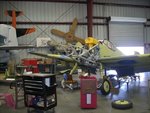Shortround6
Major General
I agree that excess power affects the ability to stay in a horizontal turn, but do not think it affect general maneuverability. The pilot is free to descend if he wants to turn tighter than his excess power will allow, right up until he gets to ground level. Of course, descending takes you out of the fight, but maybe you would rather live than remain with an opponent who is out-turning you.
The extra weight might well affect the ability to stay in formation near the service ceiling, but people generally don't stay in formation at the service ceiling anyway. Since the planes we are generally talking about are Me 109's, their service ceiling varies considerably, but let's say they have a general service ceiling of 36,000 feet. If so, and if they have the wing gondolas, then I think they could afford to fly at 32,000 feet instead since the bombers were generally not that high.
I think we are getting to a point where we are not that far apart. Think of pilots perception of an aircraft, Say for instance the 3 gun 109 can turn at 1 1/2 Gs at a certain speed at a certain altitude and climb at 1 m/s. A some what gentile turn to position the formation in an attack position? or to meet a threat? in any case the 5 gun machine, while doing the same turn at the same speed and altitude would be descending at 1m/s or more. Now if takes 20 seconds to execute a 180 degree turn at this speed and altitude the 5 gun machine is going to be 80 meters or more below the 3 gun airplane. Now are the German pilots going to think the 5 gun is "sluggish" or doesn't turn well compared to the 3 gun? If both are pulling 5 "G"s both are loosing 15-20m/s and a 2-3m/s difference is not going to be real noticeable
So, I think the effect of the gondolas on dogfight maneuverability was definitely there and definitely bad, but the effect on maneuverability when not in a dogfight was almost nothing. That is, if they were attacking from ambush, there was no effect. Most kills did not happen in a dogfight, they were made from a blind spot.
So, I think the Germans dropped the gondolas due to pilot preference and lack of demonstrable superiority to the fuselage-only configuration. The gondolas would have been a good idea if strafing beaches or troops columns, so they would have retained the gondolas and the mounts on the aircraft.
I will freely admit the gondolas were a good idea against bombers too. They may have worked OK against some Russian fighters at low altitude. If the 109 with gondolas can out climb the Russian fighter it was opposed by then then there may not have been a problem. The Problem in the west was the the "combat" height for the German fighters was about on the edge of what the "standard" 109 with a DB605 could operate at. Depending on whose chart you look at a P-51B could climb at 2000fpm at 30,000ft A P-47 at 1400-1650fpm, a P-38J at 1830fpm and the 3 gun 109G-1 was supposed to do 1640-1650fpm. Cutting the climb rate of the 109 by 400-600fpm at 30,000ft by hanging the gondolas on it was not a good idea once the escort fighters started showing up.
Well, I would note that the engine power did increase for about 1100hp to 1475hp from the E to the early G so it's ability to carry the extra weight did go up. Also the critical height of the engine went from around 4000meters to 5800 meters even before the later models with the 605 supercharger. The better streamlining of the "F" and early "G" would help climb also. I will try to give credit where I think credit is due. Pods under an "E" might have been a disaster. But then 20mm Hispanos in pods underneath a Spitfire MK I wings (and keeping the machine guns in the wing) would have been a disaster too.I doubt seriously that the gondolas would have adversely affected an E or F model, though they WOULD be noticeable and high altitude, but by the time the G-model came along, it had porked up considerably and was quite a bit heavier than an E or F model. Any extra weight would definitely have an effect on a G or later model Me 109.

